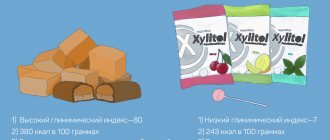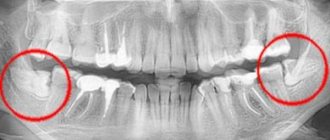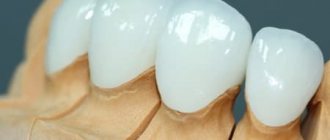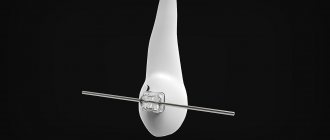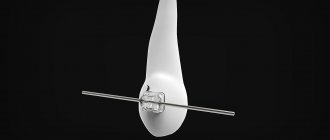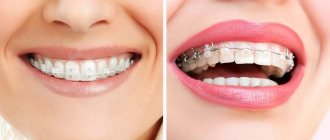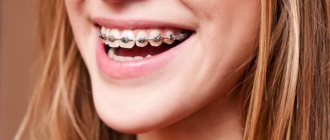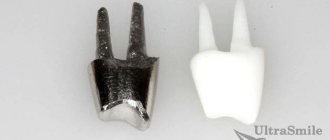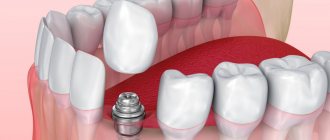A beautiful smile is a person’s calling card. There is nothing worse when problems in the oral cavity prevent a person from smiling. Modern dentistry offers various methods of tooth restoration. Small chips are masked with veneers; in more complex cases, composite materials are used, crowns are installed, enamel is restored using microprostheses, implantation and prosthetics are performed. Building a tooth onto a pin solves the client’s problem even with severe destruction (50% or more). This procedure helps correct bite or aesthetic defects. It is often compared to artistic restoration.
What is a pin
In modern dentistry, various designs are used to recreate damaged teeth.
A pin is one such structure that serves as a support for filling material or a crown. The pin is installed in the root cavity after the nerve is removed. Thanks to this procedure, it is possible to preserve the root, dentition and original structure of the jaw.
The main task of the pin, which is installed on a pulpless tooth, is to evenly distribute chewing pressure. Thus, when chewing, parts of the restored tooth will not experience increased pressure and will not be damaged.
Titanium pin in tooth
The pins located in the tooth canals can be made of titanium, but they should not be confused with implants. Dental pins belong to endodontics and partly to orthopedics, while implantation is a separate area. When a titanium pin is placed in an extracted tooth, the product is called an “implant.” This is an artificial root that is implanted in place of a lost tooth. Theoretically, a dental implant can be called a titanium post (which many people often do), but compared to classic posts, it performs a completely different function. The advantages of implantation today are undeniable: if a natural tooth is lost, it is the implant that can best restore its functionality and aesthetics.
Tooth restoration using a pin: indications and contraindications
If a tooth can be saved, then it is worth fighting for. You can always make it in time with dentures or implantation, but time is running out to save your natural tooth. In this regard, it is important to seek dental care in a timely manner. Let's consider cases when the extension procedure is appropriate and when it is not.
Indications
- Cases when the tooth is destroyed by half or more, but the root is intact. Even if the crown is destroyed, but the root is intact, then extension onto a pin is possible.
- Damage in which the degree of dentin damage does not allow filling. For restoration work, a support in the form of a pin is required to minimize and distribute the chewing load.
- Cases when a tooth needs to be restored for further dental prosthetics. In this case, the restoration is carried out with the aim of using the tooth as a support for the prosthesis.
Contraindications
- The roots of the teeth are destroyed. In this case, there is no stable support for the pin, and installing the structure is risky.
- Inflammatory diseases of the oral cavity. In particular, we are talking about inflammatory pathologies of the gums (gingivitis, periodontitis).
- Cysts, granulomas or tumors in the area of the tooth to be restored.
- Thinning of the walls of the root canals. If during diagnostics it is clear that the wall thickness is 2 mm or less, then pin restoration is not performed.
Alternative options
If tooth augmentation is contraindicated for a patient, this does not mean that a beautiful smile can be given up. Dentistry offers a number of alternative methods, among which the following are often used:
- Implantation – installation of an implant on the jaw bone. Then an abutment and crown are installed on the healed implant. The Center for Israeli Dentistry performs all types of implantation - one-stage, two-stage, All-on-6 and All-on-4 implantations.
- Installation of dental inlays is a microprosthetic option often used to restore lateral teeth. Often such inlays are used for advanced stages of caries or injuries. The production of the inlay is carried out by a dental technician, who makes the design based on a computer model of the patient’s dentition.
- Metal-ceramic crowns are a metal dental prosthesis coated with ceramics. The advantage of metal ceramics is strength, durability (up to 12 years) and aesthetics.
Alternative options for dental restoration are discussed with your doctor. The dentist will recommend the best option based on medical indications, patient preferences, and financial capabilities.
Possible contraindications
Augmentation is a fairly new technology that allows you to completely restore a lost tooth. It is not as painful as other methods, and allows you to save the tooth, even if there is only one root left.
Damaged teeth are not only a cosmetic problem, but also an excellent environment for the development of infectious diseases. The cause of injury may be temporary wear, chips, cracks or carious processes. All of these are indications for the procedure.
A contraindication to extensions is the presence of an allergy to the materials used for manipulation. It is also recommended to refuse the procedure in case of severe pathologies of the oral cavity and dysfunction of the temporomandibular joint. Some techniques have their own contraindications, of which the doctor must notify the patient.
Before and after extensions
Previously, implants were used for restoration, but thanks to modern advances, doctors can build up damaged areas of tissue. The following types of recovery exist:
- extension with composite materials;
- filling;
- pin restoration;
- installation of veneers or lumineers;
- crown covering.
What types of structures are there?
Pins differ depending on the material and type of thread. Let's look at the most popular types of structures used in dentistry:
- Anchor - made of an alloy of gold and platinum or palladium metal. There are active and passive anchor pins. In the first case, the design has a thread, in the second - without thread. The anchor pin is a rod, which is fixed in the root canal. This design provides support for both the microprosthesis and the filling. The advantage of an anchor pin is that it allows you to restore even a severely damaged tooth.
- Titanium – rod structure made of high-strength titanium alloy. This design is fixed in the root canal, often in chewing teeth, since it can withstand heavy loads. Titanium structures are suitable for bulk fillings and even prostheses.
- Fiberglass – Made from high-strength fiberglass. In terms of physical characteristics, glass fiber has similar properties to dentin tissue. Thus, when restoring with a fiberglass pin, the load on the tooth is distributed evenly. Fiberglass is used in medical practice due to its hypoallergenicity and biocompatibility. Another advantage of fiberglass is color. Such structures are colorless or resemble enamel, which is why they are also installed on the front teeth.
- Carbon fiber is the most popular type used in orthopedic dentistry. In structure and physical properties, carbon fiber structures resemble bone tissue. Such pins are characterized by both high strength and elasticity. When installing carbon fiber structures, the likelihood of root and crown fractures is minimized.
- Parapulpal - made of an alloy with stainless metal. Parapulpal structures are rarely used today. They are often installed as additional support for a filling.
Pin structures are also distinguished by shape. Based on this feature, screw, cylindrical, cylindrical-conical and conical structures are distinguished. The shape of the structure is selected depending on the structure of the root canal and the characteristics of the planned treatment.
Roll pins are used when the root strength is sufficient. They provide the patient with sufficient retention. In addition, when selecting, it is important to take into account the diameter. If the diameter of the rod is too small, then during restoration work a gap may form, which can cause the filling to become brittle and lead to infection. If the diameter is too large, there is a risk of root damage.
As for conical forms, when using such structures the risk of root damage is minimal. However, with conical pins, a wedging effect is possible during chewing.
Indications for the installation of dental pins
Until the carious lesion reaches the pulp, the sanitized cavities are closed with fillings that have sufficient adhesion to dentin and enamel. Refusal of timely therapy leads to the fact that the cost of tooth restoration becomes the need for more radical intervention: the patient will have to have a root canal treated and a pin placed.
Restoration of pulpless teeth using rods is used when 3 conditions are combined:
- The crown part is destroyed by 50% or more.
- The thickness of dentin in the treated canals is not less than 2 - 2.5 mm.
- There are no cracks or through chips at the subgingival level.
In addition, when installing a dental post, the shape of the root canals and age-related mineralization of dentin are taken into account. Round rods do not provide reliable fixation in slit-shaped and oval canals, and increased mineralization leads to the risk of dentin splitting when screwing in active pins (the so-called rods that are installed using a tension force). These factors can be considered specific contraindications for the installation of intracanal reinforcing elements.
General contraindications include inflammation, cysts and granulomas, old age, serious problems with the immune system, caries (requires preliminary sanitation), as well as a number of severe neurological and mental symptoms.
How a tooth is restored: stages of treatment
The extension procedure on a pin takes place in several stages:
- Diagnostics . Before starting the procedure, a thorough study is carried out. The patient undergoes a three-dimensional computed tomography and orthopantomogram of the jaw. It is important to consider in detail how damaged the tooth is in order to select the necessary pin and method of restoration.
- Taking impressions . To carry out restoration work, impressions are first taken. This procedure is performed if the patient has a crown installed. It is important that the crown fits anatomically into the dentition without causing discomfort to the patient.
- Bone grafting . Some patients undergo bone grafting before the augmentation procedure. This is necessary for bone deficiency.
- Installation of the pin . A pin is installed in the root. It is fixed with cement or screwed in (if the pin is active, threaded).
- Filling . The free space in the pin area is filled with composite material.
- Restoration . The final part of the procedure is when the tooth is restored. The doctor uses a durable filling material to recreate the coronal part. The restoration is carried out using a high-strength photopolymer that will last the patient up to 10 years. Now the restored part has a double support - the root and an installed pin that can withstand the loads on the tooth.
If the patient decides to undergo prosthetics, a crown is installed on the pin. Initially, a temporary crown is placed on the post. The patient stays with it until the dental technician makes a metal-ceramic crown based on the impression. The patient is then fitted with a permanent crown, secured with cement. In the future, work on polishing and correction of the permanent crown is possible.
Procedure for caring for pinned teeth
In the postoperative period, patients are recommended:
- adhere to a gentle diet, give up alcohol, cigarettes and food that can injure the epithelial tissues of the oral cavity;
- provide thorough hygienic care of teeth and oral cavity;
- floss regularly;
- do not attempt to open bottles with your teeth, do not crack the shells of nuts or seeds;
- visit the dentist at least once every six months.
It is important to understand that the appearance of pain, swelling, hyperemia or inflammation of the gums in the area of the restored tooth may indicate the development of serious complications of the procedure. For this reason, identifying the symptoms described above is the basis for contacting doctors and receiving professional medical care.
Possible complications
Every medical procedure has a risk of complications. In this case, when a pin is installed on a tooth, in rare cases the following complications arise:
- Toothache . This symptom after dental procedures is normal. To relieve pain, the doctor will prescribe medications for toothache. In most cases, pain bothers you for the first 2-4 days. If the pain does not subside within this time, consult a doctor. There may be an inflammatory process in the oral cavity caused by the tooth extension procedure.
- Root fracture . When a tooth is built onto a post, there is a risk of root fracture. The likelihood of such a complication is minimal, but it should not be excluded. Often the root is affected during the procedure when installing active anchor structures with threads.
- Chips and cracks . A pin is placed on the tooth to reduce and evenly distribute the load during chewing. Sometimes the tooth cracks or chips, unable to withstand the chewing load.
Is it worth putting a pin in a tooth?
Like all dental treatment methods, pins have their drawbacks. This list is small, but these nuances must be kept in mind before agreeing to treatment.
- Allergic reactions to metal alloys are possible.
- Even with ideal treatment, a tooth with a pin will be more vulnerable than a healthy tooth. Its service life is shortened and the tooth becomes more fragile.
- The risk of root fracture increases (especially when using classic anchor pins).
On the other hand, this technique allows you to save a tooth in almost hopeless conditions.
